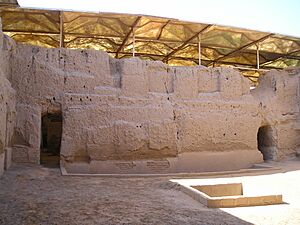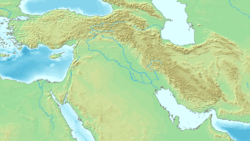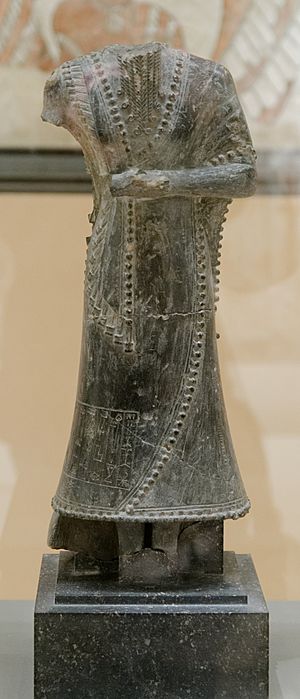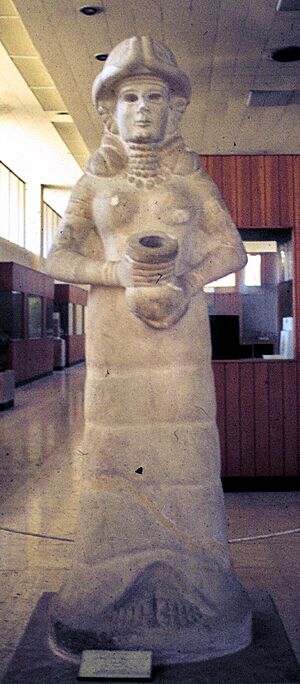Royal Palace of Mari facts for kids

The remains of the royal palace of Mari
|
|
| Location | Mari, Eastern Syria |
|---|---|
| Coordinates | 34°33′05″N 40°53′19″E / 34.551399°N 40.888473°E |
| Type | Dwelling |
| Part of | Acropolis |
| Area | 2.5 hectares (6.2 acres) |
| History | |
| Material | Stone |
| Founded | 24th century BC, last major renovation c.1800 BC. |
| Periods | Bronze – Hellenistic |
| Associated with | Yasmah-Adad, Zimrilim |
| Site notes | |
| Condition | Partial restoration |
| Public access | No |
| Active excavation | |
The Royal Palace of Mari was the grand home of the kings who ruled the ancient kingdom of Mari in eastern Syria. Mari was located in a central spot between powerful kingdoms like Palestine, Syria, and Babylon. This made Mari an important "middle-man" for trade and communication.
The palace's huge size and amazing design show how important Mari was for a long time. One of the most exciting discoveries inside the palace was nearly 25,000 clay tablets! The Royal Palace was found in 1935 and explored throughout the 1930s. It is considered one of the most important finds at Mari. André Parrot led the excavations and found both the city and the palace. The thousands of clay tablets helped archaeologists learn about daily life in the Mari palace and understand what different rooms were used for.
Exploring the Palace of Mari
The palace became its most impressive after its last big renovation under King Zimri-Lim around 1800 BC. It was not just the king's home. It also housed royal guards, government workers, soldiers, and people who managed the kingdom's daily tasks.
Protecting the Royal Family
The king's living areas were separate from the rest of the palace. They were also easy to spot during the excavations. Most rooms in the palace were connected, but the royal family's private rooms were very isolated. This design gave the king and his family a lot of privacy and kept them very safe.
The palace complex had only one main entrance gate, which added extra security. The way the palace was built also helped protect the royal family. A large central courtyard was surrounded by many smaller rooms. The entrances to these courtyards were placed so that it was almost impossible to attack anyone inside directly. Visitors could not see straight into an open courtyard. Instead, they had to change direction to enter from the side. This meant that anyone trying to use a weapon could not easily reach any room from the main gate.
Palace Decorations
The Royal Palace at Mari was decorated with beautiful paintings called frescoes and many statues. The decorations were different depending on what the room was used for. Public areas had religious and royal scenes. These showed messages about the king's power and religion to visitors and palace residents.
More private rooms, like the king's apartments, had patterns, shapes, and geometric designs. These designs made the royal family's living spaces feel luxurious. The paintings of kings and gods showed the palace's luxury, power, and authority.
Amazing Finds from the Palace
Archaeologists found many interesting things at the Palace of Zimri-Lim. These included statues and thousands of clay tablets.
Ancient Statues
Statues of gods and past rulers were common finds at the Palace of Zimri-Lim. Many of these rulers held the title of Shakkanakku, which meant military governor. These kings were descendants of governors appointed by the kings of Akkad. Statues were used to decorate both the outside and inside of the palace. King Zimri-Lim used these statues to connect his rule to the gods and to the traditions of earlier kings. Some of the most famous statues include those of Iddi-Ilum, Ishtup-Ilum, the Water Goddess, and Puzur-Ishtar.
Puzur-Ishtar's Statue
The statue of Puzur-Ishtar once stood in one of the palace's holy rooms. However, it was found in the museum of Nebuchadrezzar’s palace in Babylon (604-562 BCE). An inscription on the statue's skirt names Puzur-Ishtar, the governor of Mari. It also mentions his brother, the priest Milaga.
Puzur-Ishtar's cap has horns, which usually appear only on gods in ancient Mesopotamian art. This might have made the Babylonian soldiers think he was a god. They took the statue home as a symbol of their victory over Mari.
Ishtup-Ilum's Statue
The Statue of Ishtup-Ilum is made of basalt stone. It was found in room 65 of the palace. An inscription on his shoulder tells us this man was a governor (shakkanakku) of Mari around 2000 BCE. Ishtup-Ilum was known for giving generous gifts to the Ishtar temple. Ishtar was a popular goddess of fertility, love, and war. The statue is 1.52 meters (about 5 feet) tall. It is now in the Aleppo Museum.
Iddi-Ilum's Statue
Iddi-Ilum was another former governor of Mari. This statue shows Iddi-Ilum as a religious ruler. His hands are clasped in front of him, which was a common prayer pose in Mesopotamia. His fancy robe has a fringed edge and is wrapped around his body, which was unusual for Mesopotamian clothing.
The small statue has an inscription in Akkadian. It says: "Iddi-Ilum, governor of Mari, has given his statue to Inanna. Anyone who erases this writing will have their family line wiped out by Inanna." This statue is similar to the Puzur-Ishtar statue. Both show rulers with trimmed beards and rich clothing.
Statue of a Water Goddess
Statues of goddesses holding water were common in Mesopotamia. The statue of a Goddess holding a vase was actually a fountain. Water flowed out of the vase. This statue is almost life-size and likely stood in the palace chapel. A channel was drilled through the statue's body. This channel connected to a water supply, allowing water to flow from the goddess’s vase.
Ancient Clay Tablets
More than 20,000 clay tablets were found in the palace! According to André Parrot, these tablets "completely changed how we date the history of the ancient Near East." They also provided over 500 new place names. This helped redraw the map of the ancient world.
Many of the tablets are royal letters from the Mari kings. Others are administrative documents, like records of goods or people. Some letters are from the king to his wives, found in the women's quarters. Some even include direct quotes from King Hammurabi, suggesting they were written around the same time he ruled.
Other letters tell us about beliefs in gods and predictions in Mari and the ancient Near East. Letters from the collection include amazing information about fortune-telling, gods, and even descriptions of ancient dreams. If someone had a prophetic dream, a letter would be sent to a diviner. This person would then perform a ritual called extispicy to confirm the dream's message.
Colorful Wall Paintings (Frescoes)
Figural frescoes, or wall paintings with figures, were found in five rooms inside the Palace of Mari. Only four of these paintings could be put back together. This was because the materials had decayed and were damaged when Hammurabi of Babylon attacked Mari around 1760 BCE.
The Investiture of Zimri-Lim
"The Investiture of Zimri-Lim" painting dates back to the 18th century BCE. It was discovered during the 1935–1936 excavations by French archaeologist André Parrot. This was the only painting found in its original place in the palace. The painting is special because of its wide range of colors, including green and blue.
It was painted on a thin layer of mud plaster directly on the palace's brick wall. The scene shows a warrior goddess, probably Ishtar, giving King Zimri-Lim a ring and a staff. These were symbols of kingship. The red and blue border around the painting suggests it was one of several paintings decorating the room's walls.
Recent restoration work by the Louvre museum has revealed new details. For example, patterns on Zimri-Lim's robe and surprisingly bright colors, like a brilliant orange bull.
Sacrificial Procession Scene
Pieces of a painting showing a sacrificial procession were found at the bottom of the same wall where "The Investiture of Zimri-Lim" was found. This painting has several levels, or registers. It shows a life-size figure leading men who are guiding animals for sacrifice. The colors used are black, brown, red, white, and gray.
The way this scene was painted is different from the thin mud plaster used for other frescoes. The sacrificial procession scene used layers of mud. These layers were scratched to help a thick layer of gypsum plaster stick to them. Both paintings were in the same room. The "Investiture" scene was better preserved. This might mean "Investiture" was an earlier painting. It was then covered by the later procession scene, which protected it from damage.
|






